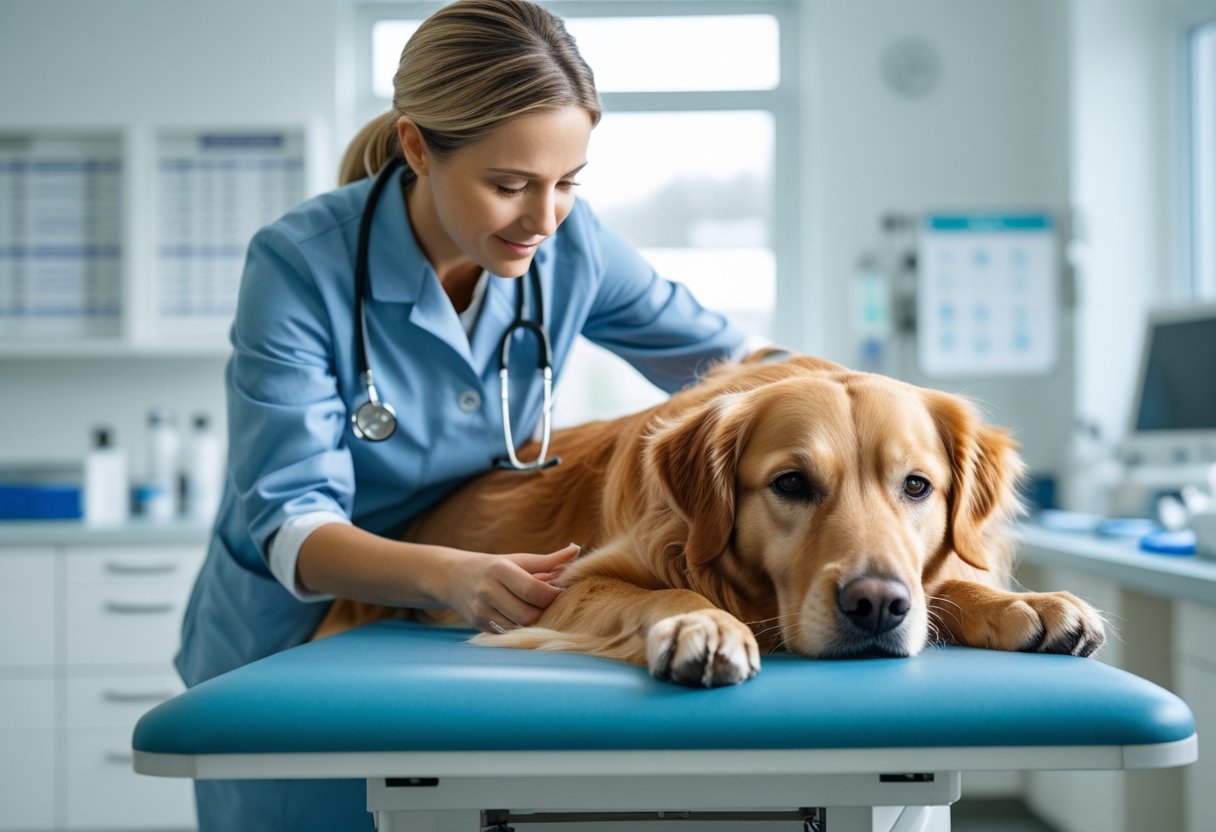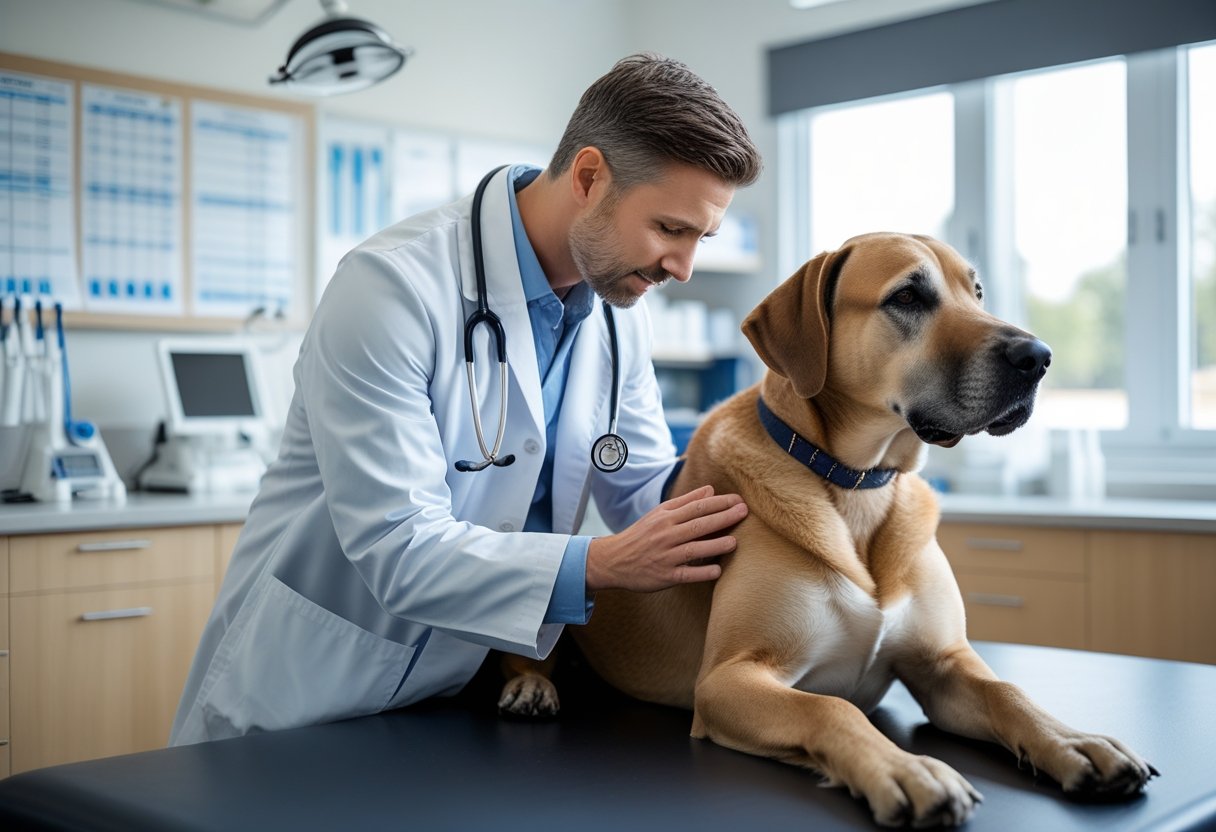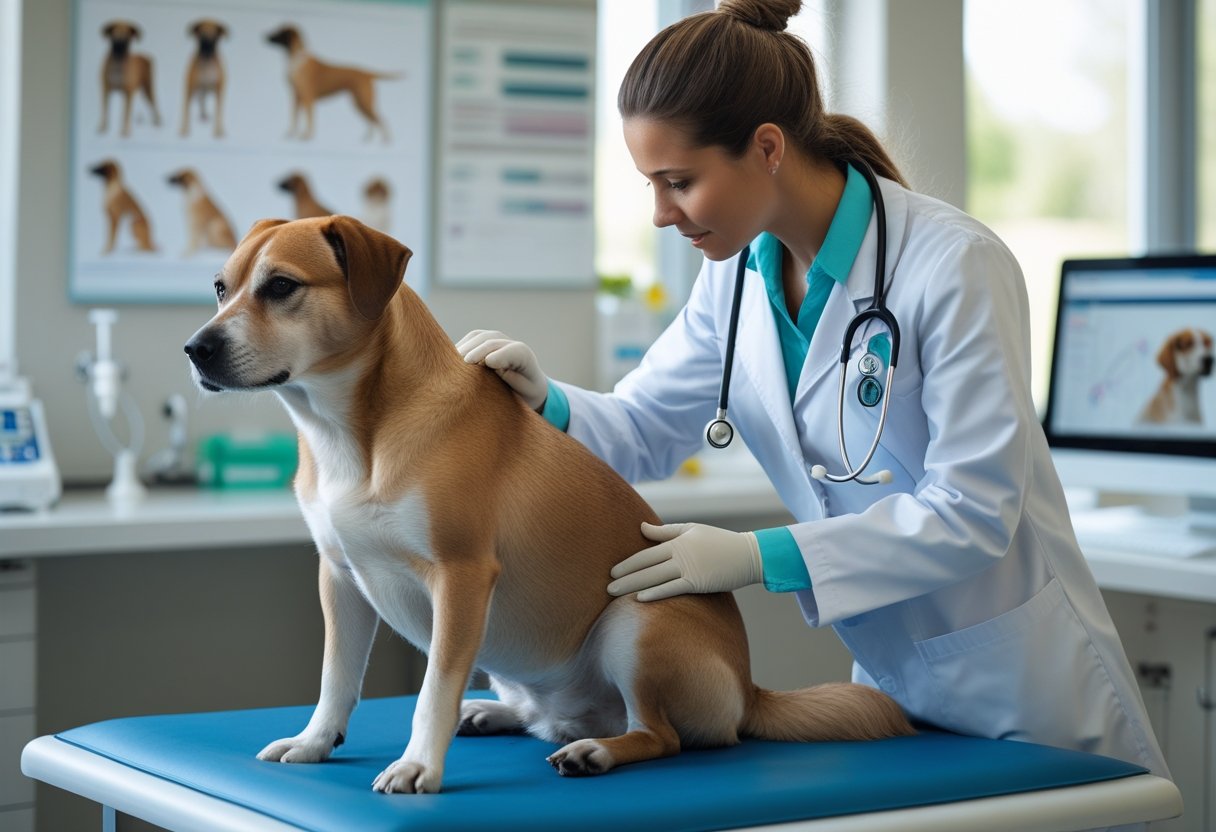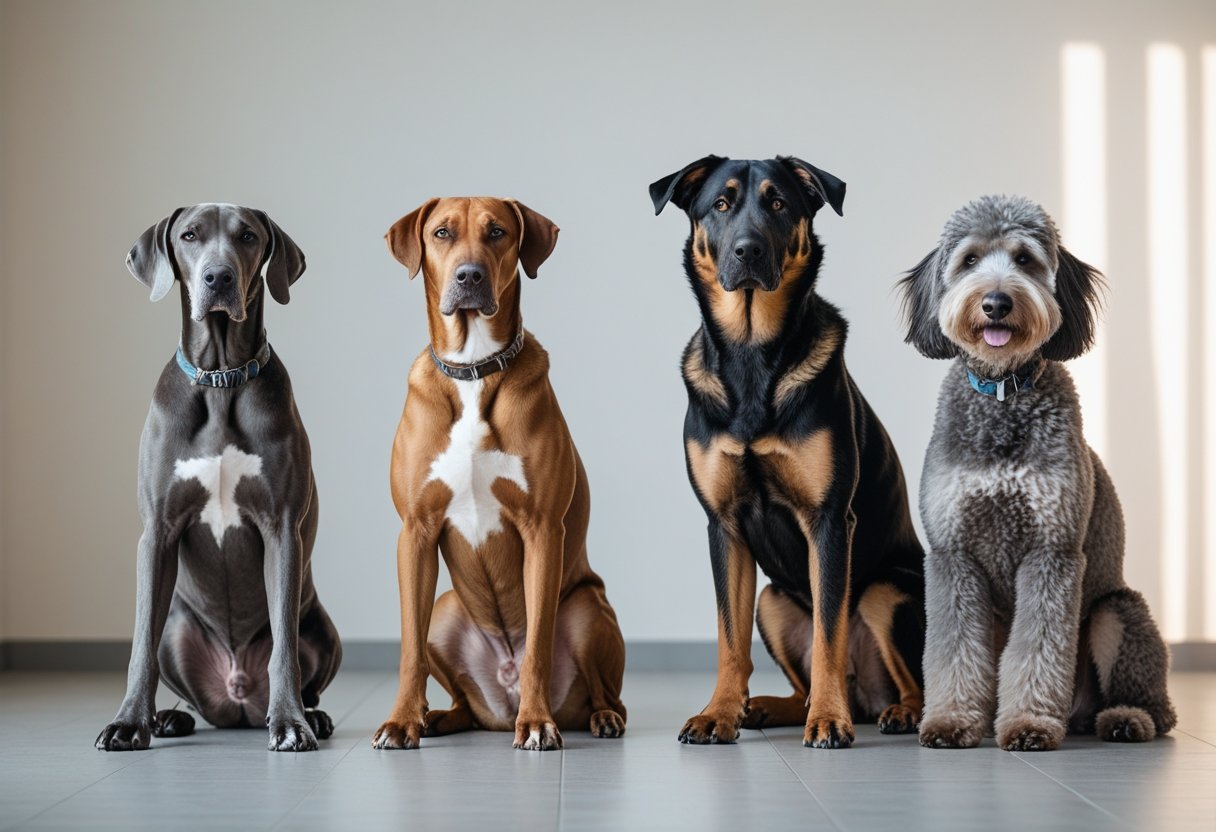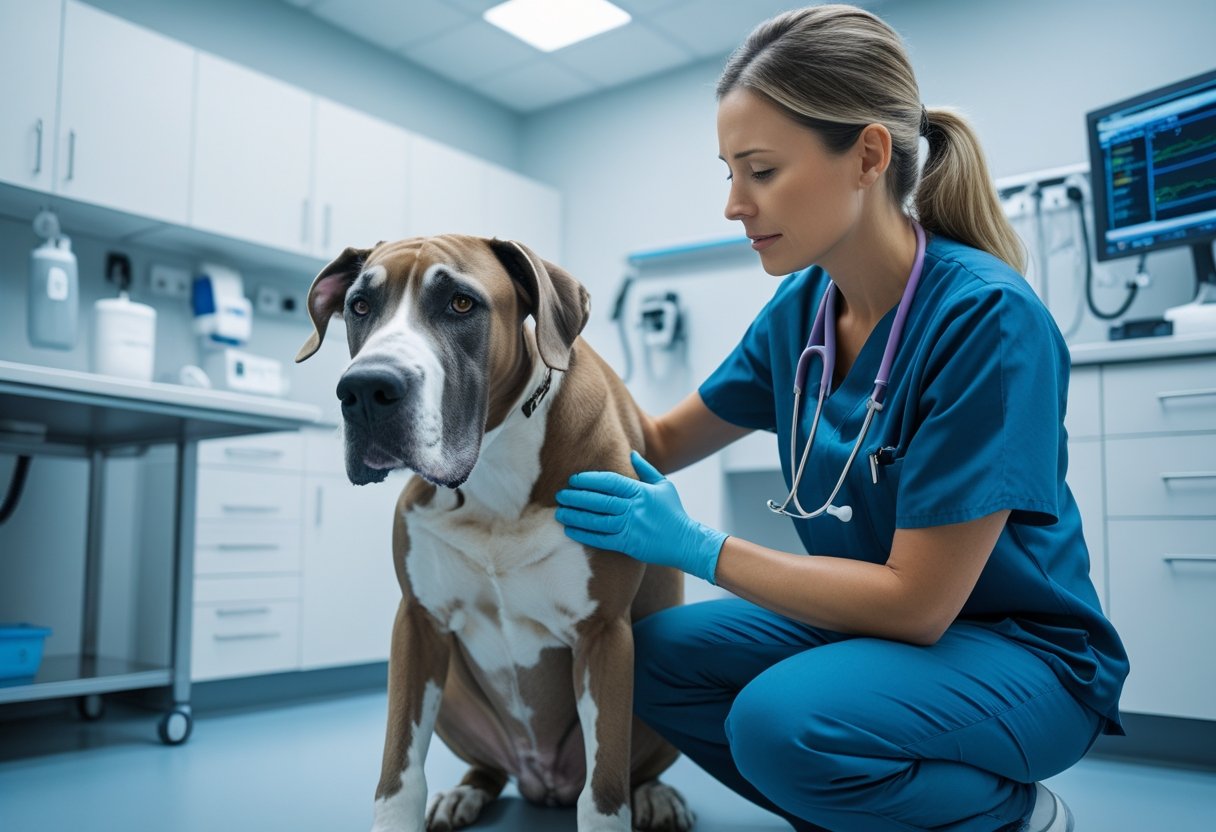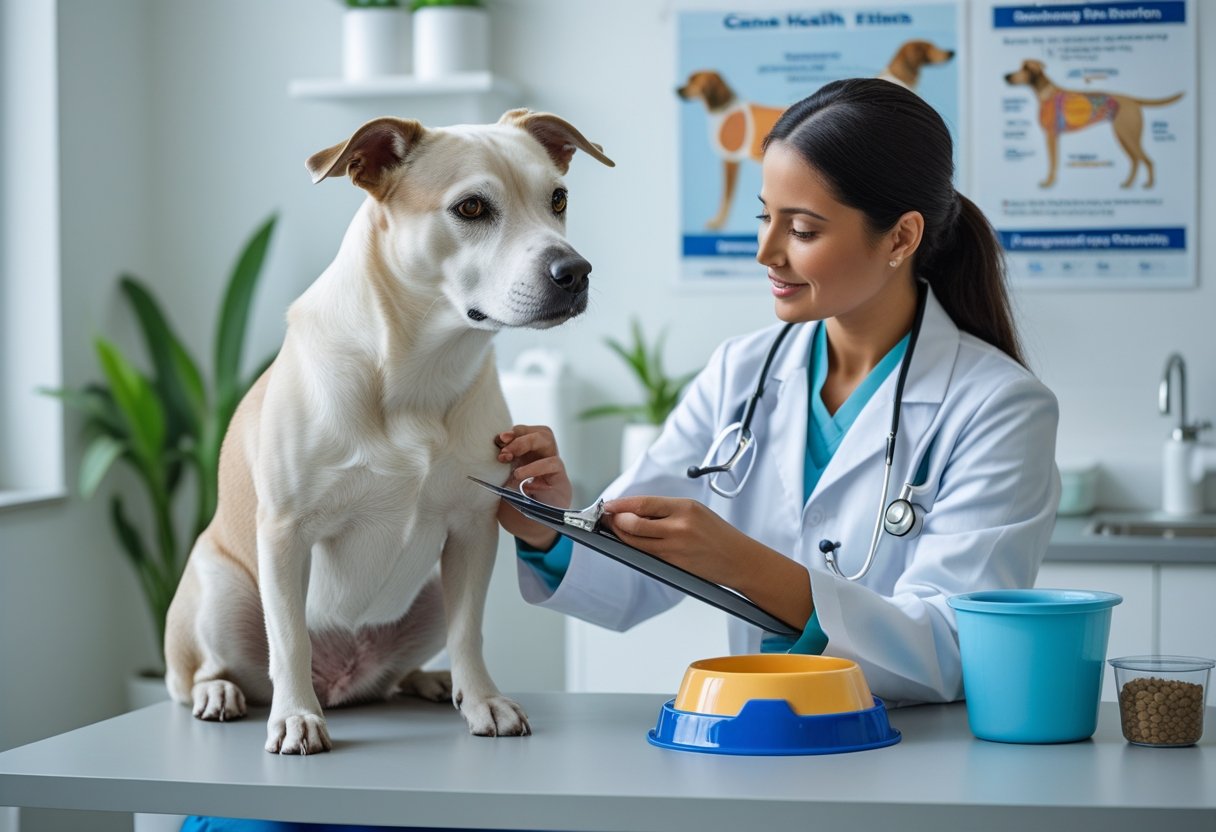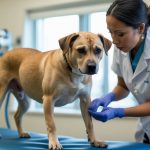Bloat in dogs can come out of nowhere and turn deadly in a flash. It’s one of those emergencies every dog owner dreads but really needs to know about.
Bloat, or gastric dilatation-volvulus (GDV), happens when your dog’s stomach fills with gas and twists, cutting off blood flow and triggering life-threatening shock. Spotting the signs early and acting fast can make all the difference.
You might see your dog’s belly swell, notice restlessness, or watch them try to vomit without anything coming up. These are red flags—don’t wait it out.
According to the Blue Cross, bloat is one of the most urgent conditions vets see, and every minute counts.
Understanding what causes bloat, which breeds are at risk, and how to respond quickly gives you the best shot at protecting your dog.
Key Takeaways
- Bloat moves fast and needs immediate vet attention.
- Spotting early signs like a swollen belly and dry retching can save your dog.
- Preventive care, calm feeding habits, and knowing the risks can lower the odds of bloat.
What Is Bloat in Dogs?
Bloat happens when a dog’s stomach fills with gas, food, or fluid and swells up, putting pressure on other organs. Sometimes the stomach twists, trapping air and cutting off blood flow.
Without urgent vet care, this can turn fatal shockingly fast.
Understanding Gastric Dilation and Volvulus (GDV)
Gastric dilation just means the stomach swells from trapped gas or food. If that swelling leads to a twist, it becomes gastric dilatation-volvulus (GDV).
Once twisted, nothing can move in or out of the stomach. The twist also blocks blood from reaching the stomach wall and nearby organs.
If it’s not treated, the tissue starts dying from lack of oxygen. According to The Kennel Club, GDV hits deep-chested breeds like Great Danes, Weimaraners, and Dobermans the most.
Vets usually confirm GDV with X-rays that show a “double bubble” pattern in the stomach. This tells them whether the stomach is just swollen or actually twisted, which guides emergency treatment.
How Bloat Develops in the Stomach
Bloat often starts when a dog eats or drinks too quickly, gulping down air with the food or water. The stomach then expands, pressing on other organs and the diaphragm—making breathing tough.
If your dog runs around right after eating, the stomach might flip and trap gas and food. This twist ramps up the pressure and pain.
As PetMD describes, once the stomach flips, blood flow to the lower body stops, causing shock.
Common early signs include pacing, drooling, retching without bringing anything up, and a noticeably swollen belly. Catching these symptoms quickly is critical.
Why Bloat Is a Life-Threatening Emergency
Bloat and GDV are medical emergencies because they quickly mess with your dog’s circulation and breathing. When the stomach twists, blood can’t return to the heart, so shock and organ failure can happen within hours.
Dogs with GDV need a vet right away. Vets might use a tube or needle to let out trapped gas, then go to surgery to untwist the stomach.
A gastropexy—where the vet attaches the stomach to the body wall—can help prevent it from twisting again.
Recognising the Signs of Bloat
Bloat can hit fast and turn life-threatening within hours. Knowing the early signs—and how they’re different from regular stomach problems—means you can act before it’s too late.
Early Warning Signs to Watch For
Bloat often begins with small changes. Maybe your dog starts pacing, looking restless, or tries to vomit but nothing comes up.
These signs might show up soon after a meal or drinking water. A swollen or tight abdomen is another big clue.
You might see your dog standing awkwardly or stretching over and over, like they’re trying to get comfortable.
Other early signs include:
- Drooling a lot
- Whining or acting like they’re in pain
- Refusing food or water
If you spot any of these, don’t wait. Get help right away. For more details, check out Signs of Bloat in Dogs.
Severe Symptoms Requiring Immediate Action
As bloat gets worse, it blocks blood flow and damages organs. At this point, your dog might have a hard, swollen belly, rapid breathing, or seem weak.
You might see pale gums, collapse, or labored breathing. These are signs of shock—get to an emergency vet immediately.
Here’s a quick reference table:
| Severe Symptom | What It Means | Action |
|---|---|---|
| Hard, distended abdomen | Gas buildup and twisting of stomach | Go to emergency vet now |
| Unproductive retching | Stomach blockage | Emergency treatment needed |
| Collapse or weakness | Circulatory shock | Call vet immediately |
How Bloat Differs from Other Stomach Issues
Simple tummy upsets usually get better with rest and water, but bloat just gets worse. A dog with indigestion might throw up once and bounce back.
With bloat, your dog keeps trying to vomit but can’t. The belly swells up fast and feels tight, and your dog may act anxious or panicked—not just uncomfortable.
If you’re not sure, assume it could be bloat and call your vet. There’s more on telling the difference at Bloat In Dogs: Signs, Causes, And What To Expect From Treatment.
Risk Factors and Breeds Prone to Bloat
Some dogs just have a much higher risk of bloat, or gastric dilatation-volvulus (GDV), because of their body shape, genetics, and even their daily habits. Knowing these risk factors can help you protect your dog and act quickly if you ever see symptoms.
Why Deep-Chested Dogs Are More Vulnerable
Dogs with deep, narrow chests have a body shape that lets the stomach shift and trap gas more easily. This makes the stomach more likely to twist, which is what GDV is all about.
You can usually spot a deep-chested dog by the way their chest drops down and tucks sharply at the waist. Breeds like Great Danes and Weimaraners fit this look.
There’s just more room for the stomach to move and flip inside the abdomen, which raises the risk for gas build-up and rotation. Even smaller deep-chested breeds, like Basset Hounds, can get bloat if they eat too fast or gulp air while panting.
According to Great Pet Care, large and giant breeds with this body shape are at the highest risk, so owners need to pay close attention.
Age, Genetics, and Lifestyle Influences
Older dogs are more at risk because their stomach muscles lose tone over time. Dogs over three years old get GDV more often.
If a close relative had bloat, your dog’s chances go up. Certain genetic lines, especially in breeds like Collies and German Shorthaired Pointers, have mutations that slow down how the stomach empties, letting gas build up.
Lifestyle matters, too. Dogs that gulp food, eat one big meal a day, or use raised bowls face higher risk. Giving smaller meals more often and using slow-feeder bowls can help.
As The Grubby Puppy points out, even stress and anxiety can play a role by making dogs swallow extra air. It’s a lot to consider, but a few changes can really help keep your dog safer.
Common Breeds at Higher Risk
Some breeds pop up again and again in veterinary studies on GDV. The table below highlights several breeds known to have higher risk levels:
| High-Risk Breeds | Typical Traits |
|---|---|
| Great Dane | Giant size, deep chest |
| German Shepherd | Active, narrow chest |
| Boxer | Deep chest, fast eater |
| Irish Wolfhound | Tall, lean build |
| Weimaraner | Athletic, deep chest |
| Standard Poodle | Long legs, narrow body |
| Irish Setter | Genetic predisposition |
| Collie | Deep chest, family history of GDV |
Large Labradoodles and Goldendoodles with deep chests also face increased risk, as noted by iHeartDogs. Any dog can develop bloat, but knowing your breed’s anatomy and habits helps you take steps that might save your dog’s life.
Causes and Triggers of Bloat
Bloat in dogs, or gastric dilation-volvulus (GDV), usually develops from a mix of eating habits, physical activity, and individual risk factors. It’s a tricky blend, honestly—understanding how these things interact can help you lower your dog’s odds of facing this scary condition.
Eating Habits and Mealtime Behaviours
How and when your dog eats plays a big role in bloat risk. Dogs that eat large meals quickly swallow extra air, which can make the stomach expand with gas.
This distension sometimes leads to twisting of the stomach. Feeding one large meal a day instead of smaller, frequent meals increases the chance of bloat.
You can help by offering two or three smaller portions throughout the day. Some owners use slow-feeder bowls to cut down on gulping.
According to Vet Explains Pets, feeding from elevated bowls may actually raise the risk because dogs swallow more air. Avoiding rapid eating and encouraging calm mealtimes can make a difference.
| Feeding Practice | Effect on Bloat Risk |
|---|---|
| Large single meals | Increases risk |
| Multiple small meals | Reduces risk |
| Elevated bowls | May increase risk |
| Slow-feeder bowls | Helps reduce gulping |
Exercise and Environmental Stressors
Physical activity and emotional stress can also trigger bloat in dogs. Vigorous exercise right before or after eating can cause the stomach to shift and trap gas.
Waiting at least an hour before or after meals for play or walks helps digestion. Stressful environments, loud noises, or changes in routine may also play a part.
The Kennel Club points out that anxiety affects digestion and can increase gas buildup. Keeping your dog’s routine predictable and calm helps maintain healthy digestion.
Try creating a quiet eating space, avoid rushed feeding times, and offer regular, gentle exercise. It’s not always easy, but it’s worth it for their gut health.
Other Contributing Factors
Some dogs are just more prone to bloat. Large and giant breeds with deep chests, like Great Danes and Weimaraners, face higher risk because of their body structure.
Blue Cross explains that this shape makes it easier for the stomach to twist. Age and genetics matter too—older dogs may have weaker stomach muscles, and some family lines show a hereditary tendency toward gastric dilation.
Diet composition can tip the scales. High-fat foods, sudden diet changes, and ingredients like soy or corn might upset digestion. Offering a balanced, easily digestible diet supports gut health and lowers the chance of bloat.
Emergency Response: What to Do If You Suspect Bloat
If you notice your dog showing signs of bloat—like restlessness, retching without bringing anything up, or a swollen belly—every minute counts. Quick action, calling an emergency vet, and knowing what to expect at the clinic can really change the outcome.
Immediate Steps to Take
If you suspect bloat, stay calm but act fast. This condition, also called gastric dilatation-volvulus (GDV), can turn life-threatening within hours.
- Call your nearest emergency vet immediately. Tell them you’re coming with a suspected bloat case so they can prep.
- Don’t give food, water, or medication. Anything by mouth could make things worse.
- Keep your dog still and calm. Too much movement can make the stomach twist further.
Watch for these signs of bloat:
| Warning Sign | Description |
|---|---|
| Swollen or hard abdomen | May look tight or distended |
| Unproductive retching | Tries to vomit but nothing comes up |
| Restlessness | Pacing, drooling, or can’t settle |
For a more detailed checklist of what to do before you get to the vet, check out Vet Emergency 2025: First Aid for Bloat in Dogs.
When to Contact Your Emergency Vet
Call your emergency vet as soon as you spot symptoms. Don’t wait and see if they pass—bloat moves fast, cuts off blood flow, and can lead to shock.
Describe your dog’s behaviour clearly—mention any retching, bloating, or collapse. The vet might give you transport tips or get a team ready for immediate care.
If your regular vet is closed, reach out to an emergency clinic or animal hospital. You can also use online services like the Ask A Vet app for quick advice while you’re en route.
Acting early improves your dog’s chance of survival, as Blue Cross explains.
What to Expect at the Veterinary Clinic
At the clinic, the veterinary team will move fast to stabilise your dog. They’ll start with a physical exam and X-rays to check if the stomach has twisted.
Your dog will probably get IV fluids for shock and oxygen support if needed. The vet may try to decompress the stomach with a tube or, if that doesn’t work, insert a needle through the abdomen.
Most dogs with confirmed GDV need emergency surgery to untwist the stomach and help prevent it from rotating again. This procedure, called gastropexy, greatly lowers the risk of recurrence.
You can read more about what happens during treatment at The Pet Vet’s guide on bloat in dogs.
Treatment Options and Recovery
If your dog develops bloat or gastric dilatation-volvulus (GDV), quick veterinary care can literally save their life. Treatment focuses on stabilising your dog, relieving pressure in the stomach, fixing any twisting, and trying to keep it from happening again.
Initial Stabilisation and Decompression
The first step is to stabilise your dog. Vets usually start intravenous fluids to treat shock and improve circulation.
Pain relief helps keep your dog calm and reduces stress on their body. Once stable, the vet will work to decompress the stomach.
This might mean passing a stomach tube through the mouth to let out trapped gas and fluid. If the stomach has twisted, the vet may insert a large needle through the skin to relieve pressure for now.
These emergency steps buy time before surgery. According to Blue Cross, bloat can become life-threatening within hours, so early intervention is critical.
Surgical Interventions for GDV
If the stomach’s twisted, surgery is the only real fix. During the operation, the vet untwists the stomach and checks for any tissue that’s lost blood supply.
They’ll remove dead tissue to prevent infection or further trouble. A procedure called gastropexy is often done at the same time, tacking the stomach to the abdominal wall to stop it from twisting again.
PetMD points out that gastropexy greatly reduces the risk of recurrence. Surgery usually takes one to two hours.
Your dog will be under general anaesthesia and closely watched for heart rhythm changes, which can happen after GDV. Most dogs stay in the hospital for a few days to recover and get supportive care.
Post-Treatment Care and Monitoring
After surgery, your dog needs rest, gentle care, and close monitoring. The vet will watch heart rate, breathing, and hydration.
Pain meds and antibiotics may be prescribed to help healing and prevent infection. You’ll need to manage your dog’s diet carefully.
Offer small, frequent meals and avoid vigorous exercise for at least two weeks. Using a slow-feeder bowl can help reduce gulping and air intake, lowering the risk of future issues.
As Veteris notes, most dogs recover well with prompt treatment, and survival rates can reach around 80%. Regular check-ups help make sure the stomach heals properly and no complications pop up.
Prevention and Long-Term Management
Preventing bloat in dogs really comes down to how your dog eats, how stressed they feel, and sometimes, surgery—especially for breeds that seem to draw the short straw genetically. By tweaking feeding habits and keeping routines calm, you can lower the odds of this scary condition showing up.
Feeding Strategies and Routine Adjustments
How you feed your dog matters a lot. Try offering smaller, more frequent meals instead of dumping everything in one go.
This approach helps cut down on gas buildup and keeps digestion moving along.
Don’t feed your dog right before or after wild play sessions. Give it at least 30–60 minutes between eating and any intense activity to avoid extra air getting swallowed.
People used to think elevated bowls helped, but studies now say they might increase the risk of gastric dilatation-volvulus (GDV). Just keep the food bowl on the floor.
If your dog bolts their food, a slow-feeder bowl or puzzle feeder can really help. These tools make meals last longer and turn eating into a bit of a game.
Preventive Vet points out that slowing down eating can actually lower the chance of gulping air and the stomach twisting.
Water should always be around, but try to stop your dog from gulping down huge amounts, especially after play. Offer small sips often, not giant gulps.
Prophylactic Gastropexy for At-Risk Dogs
For deep-chested breeds like Great Danes, Weimaraners, and Standard Poodles, prophylactic gastropexy is a real consideration. This surgery attaches the stomach to the abdominal wall, so it can’t twist if it fills with gas.
The procedure won’t stop bloat itself, but it keeps the stomach from flipping—a key part of GDV. A lot of vets suggest doing it during a spay or neuter since the dog is already under anaesthesia anyway.
The Preventive Vet guide says a gastropexy usually costs £1,600–£2,800, depending on where you live and how complicated the surgery is. It’s a one-and-done deal with long-term benefits for high-risk dogs.
If your dog has a close relative who’s had bloat, definitely bring this up with your vet. Sometimes, being proactive is the safest bet.
Reducing Stress and Promoting Gut Health
Stress can mess with your dog’s digestion and set the stage for bloat. Make mealtimes calm by feeding your dog away from other pets.
This helps prevent scarfing down food from competition. Stick to a steady daily routine—dogs really do love predictability, and it helps their digestion stay on track.
Don’t switch foods or portion sizes abruptly. For exercise, go for gentle walks instead of rough play right after meals.
Light activity aids digestion but doesn’t put pressure on the stomach. Feed a balanced diet and, if your vet’s on board, try probiotics or fibre supplements.
The Pet Vet mentions that treating underlying digestive issues like allergies or IBD can also help lower risk.
Frequently Asked Questions
Spotting bloat early can absolutely save your dog’s life. Here’s a quick look at what to watch for, what to do, and how little daily choices—like meal routines and portion sizes—really do matter.
What signs should you look out for to recognise if your dog might be suffering from gastric torsion?
Watch for a swollen or hard belly, restlessness, pacing, or attempts to vomit with nothing coming up. Dogs might drool a lot and seem anxious or uncomfortable.
If you see these, it could mean gastric dilatation-volvulus (GDV), which is a true emergency.
How can we prevent our furry friends from experiencing discomfort due to excessive gas?
Feed smaller meals throughout the day instead of one big one. Slow down their eating with a slow-feeder bowl if they’re a speed-eater.
Keep play and meals at least an hour apart, just like Blue Cross recommends.
What are the best steps to take if you suspect your dog has a distended stomach?
Call your vet right away and tell them what’s going on. Don’t try home remedies or wait it out—bloat can get much worse in just a few hours, as The Pet Vet explains.
Are there specific breeds that are more prone to developing this condition, and how can we be extra vigilant for them?
Large, deep-chested breeds—think Great Danes, German Shepherds, Boxers—face a higher risk. If you have one, pay close attention to their eating habits.
It’s worth chatting with your vet about preventive surgery like gastropexy, as PetMD suggests.
Could you tell us about the dietary changes that might help in reducing the risk of this issue in dogs?
Pick high-quality dog food and skip brands that put oils or fats at the top of the ingredient list. Feed smaller, more frequent meals, and don’t let your dog drink a ton of water at once.
These simple tweaks could help reduce the risk of bloat in dogs.
What immediate actions should we consider if we notice our dog showing symptoms of a swollen belly?
If your dog’s abdomen looks swollen or they seem distressed, get them to an emergency vet right away. Don’t try to relieve the pressure yourself.
Time really matters here—quick treatment can mean the difference between recovery and a fatal outcome, as Emergency Veterinary Care Centres points out.



